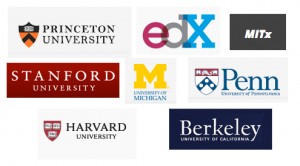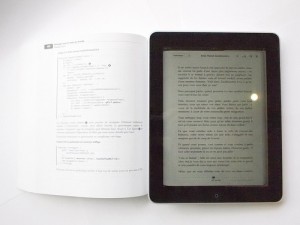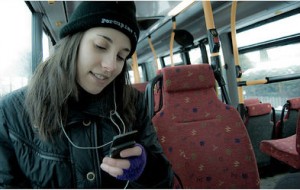Technical concerns were front-and-center at a Consortium for School Networking/SIIA Feedback Forum held with district and state officials during the ISTE 2012 conference. While WiFi and devices may exist in a school district, distribution can be lumpy, creating hurdles to smooth implementation. “We have schools that are one hundred percent textbook, and schools that are fully digital -- a broad spectrum,” said a Louisiana-based tech coordinator.
It is, one administrator from a California district noted, the last mile Internet connection into schools and even individual classrooms “where things get interesting.” Which renders paper as a cheap, convenient delivery mechanism, a good option -- for now.
 2. MOOCs AND BLENDED LEARNING FLOURISH
2. MOOCs AND BLENDED LEARNING FLOURISH
Perhaps the most-covered trend in 2012 is the MOOC movement -- Massively Open Online Courses in higher education -- so pervasive it is now also getting noticed at K-12-focused events. Investors and media are paying close attention to Coursera, edX, Udacity, and other major players. But the attention paid to the newest MOOCs seemed to overshadow awareness of the progress being made in another online instructional area: K-12 web-only and blended learning.
When it comes to blended learning, one of the biggest challenges this year echoed at ed-tech conferences was agreeing on a clear definition. The Innosight Institute in 2012 simplified its original 40 blended learning profiles to a more manageable number -- four models. Perhaps symptomatic of the need for clarity, at one event a representative of a well-known education company claimed it had “invented” blended learning because its reading intervention software existed on computers years ago.
3. MALLS, CHURCHES, BUSES: SCHOOL IS EVERYWHERE
Online learning aside, the physical definition of “school” and its borders are noticeably expanding, and not just to the home.
At the EdNET 2012 conference, online program manager Gloria L. Keaton of Annapolis Road Academy in Prince George’s County Public Schools, MD, noted that online learning labs don’t have to be in school buildings. “Let’s have a lab in a shopping mall. Kids go there. Teachers go there.”
An administrator from Arizona, speaking at the CoSN/SIIA Feedback Forum, said his district started putting WiFi on buses because kids have an hour-and-a-half ride each way. At that same session, a Chicago-area district official said his schools were working with malls and other public areas to install WiFi for students to use while studying. And a Louisiana tech coordinator said churches, as gathering places, are putting in WiFi to become community centers for studying.
Summed up the CoSN/SIIA facilitator: “The last mile (for school Internet access) is changing. But you’re not responsible for that last mile.”
4. MOBILE AND BYOD: THE CLASH OF REALITY AND POTENTIAL
Discussion of mobile devices -- school or student-owned -- was a huge topic of conversation in 2012. (Check out ZDNet's post tracking iPad adoption.)
But as with infrastructure, reality lagged behind enthusiasm. Flybridge Capital’s Matt Witheiler opined at SIIA’s Ed Tech Business Forum that mobile education was “under-invested.” At the CoSN/SIIA Feedback Forum, one Oklahoma district tech said he passed out iPads to all teachers on the first day of school, but “a month later all the teachers were complaining they couldn’t get online when they wanted.”
As to students bringing their own devices? It’s a misconception that BYOD is a common policy, said Peter DeWitt, principal of Poestenkill Elementary School in upstate New York and a popular ed-tech blogger, at EdNET 2012. With pressures of Common Core curriculum, teacher evaluations, new tests and other higher priorities sucking all the time out of the school day, “I don’t think schools are prepared for BYOD. I want them to be,” he said. Issues include teacher control, teaching kids to use their devices on school properly, infrastructure and number of tech support staff.
On the plus side, “The iPad has been one of the elements of seismic change, because of how it opened people’s minds,” said David Straus, vice president of product at Kno at the SIIA Ed Tech Industry Summit.
5. FLOOD OF MONEY CHASING ED TECH
This year saw so much investor, startup and news media attention paid to ed tech, that by this fall whispers began about the potential of a bubble, one that might drag teachers and students who depend on the latest products down with the overheated companies should it pop.
At year’s end the whispers had become chatter as investors met with the industry at the SIIA Ed Tech Business Forum in New York City. “There’s more money than talent,” said City Light Capital’s
Josh Cohen, bluntly stating a common attitude. He added that while his firm has invested in higher education, it has “been looking to do a K-12 deal since 2004 and still haven’t found the right one.” Overall, Chief Strategy Officer Diana Rhoten of Amplify observed, “The startup end of the space is extremely over-inflated.”
As for the traditional educational publishers, only Pearson is an active strategic investor among the major players, according to Baran Rosen of Whitestone Communications. Others, such as Houghton Mifflin Harcourt and McGraw-Hill, “have fallen behind” due to internal issues, flagging sales and other distractions. But Rosen noted investors view the appeal of education as huge, “second only to health care” in size.
MISCELLANY
Finally, there’s the trend category of "lots of talk," nascent widespread adoption. Big or portable education data is not quite there yet, but there’s been lots of promising activity with the Shared Learning Collaborative and the U.S. Department of Education’s MyData initiative. The maker movement is cool, but hardly ubiquitous in most traditional K-12 schools. Digital badges for informal (and some formal) learning trumpeted by Mozilla Open Badges and the MacArthur Foundation are still in early development stages.
There’s just one caveat about trying to divine trends from these half-dozen events. As Justin Serrano, President of Kaplan K12 Learning Services, quipped at the Software and Information Industry Association’s Ed Tech Industry Summit last spring, “Sometimes these conferences are a little bit like a Dead show. You see the same people moving from one to another.”




